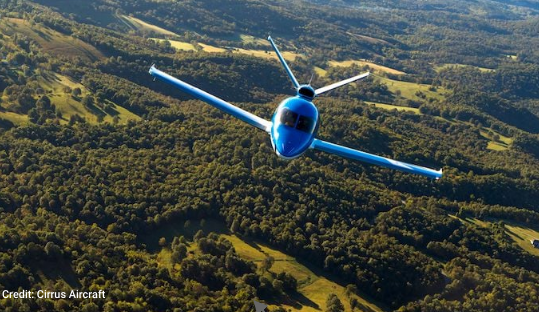Aircraft Overview: Cirrus Vision Jet
Aircraft Overview: Cirrus Vision Jet

Cirrus Vision Jet
The Vision Jet is a single-engine jet produced by Duluth, Minnesota-based Cirrus Aircraft.
Representing the commercial designation of the company’s SF50 type, the Vision Jet was certified by the FAA on Oct. 28, 2016.
Subsequently, Cirrus unveiled the second-generation of the Vision Jet—marketed as the G2 Vision Jet—on Jan. 8, 2019, an airframe that features improvements to the avionics, cabin and performance.
A further-enhanced version of the SF50 type—the G2+ Vision Jet—was announced by the manufacturer on July 20, 2021, with that airplane's improvements including engine performance that is "optimized" and in-flight Wi-Fi.
According to the FAA type certificate data sheet (TCDS) for the SF50, the airframe is capable of accommodating a maximum of seven seats, with the standard features of the G2+ Vision Jet including “modular seating for five adults.”
Those passengers are seated in a cabin that is promoted by the airframe manufacturer as being the largest in its class, as well as having a height of 4.1 ft. and width of 5.1 ft.
Additionally, up to 300 lb. of baggage are able to be carried in the aft compartment, and available cabin options include an entertainment display that measures 22 in., an executive seating configuration, “rear passenger climate controls” and sixth and seventh seats that are located in the third row of seating.
The single required pilot operates the Vision Jet using avionics that are based on Garmin’s G3000 integrated flight deck—marketed as the Perspective Touch for the first-generation Vision Jet and the Perspective Touch+ for the G2 and G2+ Vision Jet—and which includes a pair of 14-in. widescreen displays.
On the G2+ Vision Jet, those displays are supplemented by standard avionics hardware that includes dual air-data computers, attitude heading reference systems (AHRS), pitot static and communication, navigation and wide area augmentation system (WAAS) GPS radios, as well as a NextGen transponder that is automatic dependent surveillance – broadcast (ADS-B) Out capable.
Garmin’s GFC 700 autopilot—which has features such as autopilot stall protection, Electronic Stability & Protection (ESP), an emergency descent mode and the Blue Level button—is also standard, as is ADS-B In traffic and weather, FliteCharts and SafeTaxi, synthetic vision technology (SVT) and a Class B terrain awareness and warning system (TAWS-B).
The single required pilot operates the Vision Jet using avionics that are based on Garmin’s G3000 integrated flight deck—marketed as the Perspective Touch for the first-generation Vision Jet and the Perspective Touch+ for the G2 and G2+ Vision Jet—and which includes a pair of 14 in. widescreen displays.
On the G2+ Vision Jet, those displays are supplemented by standard avionics hardware that includes dual air-data computers, attitude heading reference systems (AHRS), pitot static and communication, navigation and wide area augmentation system (WAAS) GPS radios, as well as a NextGen transponder that is automatic dependent surveillance – broadcast (ADS-B) Out capable.
Garmin’s GFC 700 autopilot—which has features such as autopilot stall protection, Electronic Stability & Protection (ESP), an emergency descent mode and the Blue Level button—is also standard, as is ADS-B In traffic and weather, FliteCharts and SafeTaxi, synthetic vision technology (SVT) and a Class B terrain awareness and warning system (TAWS-B).
The Vision Jet’s autothrottle—a feature that was introduced as an option on the G2 and which is standard on the G2+—is described as being a first-in-category feature that “integrates with the autopilot” and which has the ability to change the airframe’s “speed for each phase of flight.”
Also standard on the G2+ is Garmin’s emergency autoland technology, which Cirrus markets as the Safe Return system.
Unlock the data behind the charts with Aviation Week Intelligence Network’s Fleet & Data Services. Learn more at aviationweek.com/bcaaircraftoverview.
For a comprehensive Program Profile including recent articles, program suppliers and current operators, please access via AWIN subscription here.
Variants
Powering the SF50 is a single Williams International FJ33-5A turbofan engine that has takeoff and maximum continuous thrust limits of 1,846 lb., with a full authority digital engine control (FADEC) system also being a standard feature on the G2+.
Specific to the G2+ Vision Jet’s FJ33 engine, it is promoted as having an “optimized thrust profile” that enhances takeoff performance by as much as 20%.
Beyond being limited to a 6,000-lb. maximum takeoff gross weight and a 5,550-lb. maximum landing weight, the G2+ Vision Jet also has a basic empty weight of 3,550 lb. and a usable fuel capacity of 296 gal.
It is also certified for flight into known ice, while another safety feature incorporated into the airframe is the standard Cirrus Airframe Parachute System (CAPS).
Mission and Performance
Operating limitations for the SF50 type include a maximum operating speed (VMO) and Mach number (MMO) of 250-kt. indicated airspeed (KIAS) and 0.53 Mach, respectively.
The SF50 is also limited to a maximum operating altitude of either 28,000 ft. or 31,000 ft., the latter of which was introduced on the G2 Vision Jet.
Other performance figures for the G2+ Vision Jet include a takeoff ground roll of 1,910 ft.—as well as a takeoff distance over a 50 ft. obstacle of 3,192 ft.—a landing ground roll of 1,628 ft. and a maximum cruise speed of 311-kt. true airspeed (KTAS).
Cirrus Vision Jet Images
Aviation Week Network is home to market-leading data and intelligence products. Find out which database is best for your business.
www.aircharterguide.com/
www.aircraftbluebook.com
www.acukwik.com/Products
www.airportdata.com
www.fleet.aviationweek.com